Story and photos by Jeremy Stewart: Updated August 18, 2016
For the last 20 years, I have been in love with motorcycles. I love their simplicity, their speed and, sorry for the cliché, the feeling of freedom I get while riding.
I’m on my seventh bike now. Each one has been different—Sport, Cruiser, Vintage. All street bikes, except for the 1983 Honda XL 250 on which I first learnt to ride.
Having sold my last bike to help finance a six-week trip through Southern and Eastern Africa, I was without a bike for more than a year and I was starting to go a bit crazy.
Why Triumph?
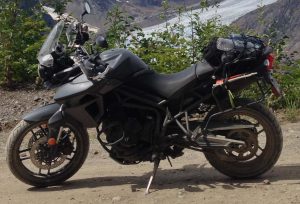
2016 Triumph Tiger 800 XR. Photo: Jeremy Stewart
I considered the very popular BMW GS, but wanted something different. And I didn’t want another Japanese bike. British vehicles are a family tradition, so I was biased towards Triumph. I had my eye on a 2016 Triumph Tiger 800 XR because I liked the idea of adventure touring. The Triumph’s 800cc speed triple engine has lots of power, but isn’t too big and heavy. It has also received great reviews.
However, the main selling point was the wicked price point James McChesney at International Motorsports Vancouver offered me. To be honest, I’ve always been too stingy to buy a brand new vehicle, but McChesney’s price point clenched my decision.
Once purchased, I couldn’t stop myself from putting 10,000 kilometres on the Triumph in three months.
Road trip
In 2001, I rode across British Columbia on a Suzuki GSX 750 with a friend who rode a Honda CBR 750. The best part about that trip was the ride to Creston and back—even though the GSX 750 was made for short sprints, not full days. It was on that trip that my friend on the CBR gave me the idea of riding to Alaska. For the last 15 years I’ve wanted to see the northern part of North America via motorcycle, but something real or imagined always kept getting in the way—work, relationships, finances, not having the “right” bike, not the right “time”, or friends who wanted to go with me “next year …for sure.” This year, I had the right bike, two weeks of vacation days and a supportive wife. No more excuses.
First stop, Calgary
Once I realized that everything had just fallen into place, I was on the road two weeks later. The first stop was Calgary. Wrong direction? Nope. The best place to start a 7,500-kilometre solo journey is with family and friends. A cousin’s wedding in Calgary was a big reunion with family arriving from all over the world. ‘Flying’ through the Rockies on two wheels for a few days spent celebrating with friends and family would have been a good trip on its own, but that was just the start…
After the wedding, I left Calgary at 6am and headed north. The thermal underwear I had was a lifesaver. Checking average temperatures, especially after passing through Kamloops, I thought I would be pretty warm in July. The Prairie winds soon taught me a lesson. Most of that day was spent going in straight lines, while being slapped upside the helmet with cross winds.
It was the inverse of a drive I did across Australia’s Nullarbor, the world’s longest straightest stretch of road.
I made good time, stopping only for fuel when I started running low near Crooked Creek, Alberta. I refuelled at the general store, which also sold coffee and donuts. Over the years, I’ve eaten more donuts than all the cops who’ve ticketed me and I have to say that the Crooked Creek General Store has the best donuts I have ever tasted.
Alaska Highway
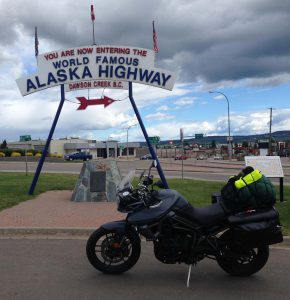
Dawson Creek in northeastern B.C., derives its name from the creek of the same name that runs through the community. Photo: Jeremy Stewart
I passed through Dawson Creek shortly after refuelling and on seeing the sign “Start of the Alaska Highway” it really started to sink in. I was finally doing this. It was the fourth of July and I made camp at the Peace River.
Despite day one’s donuts, the next leg of my journey was one of the best. Cutting back into the Rockies, the weather was really bad at first, but it got better just as I got to Stone Mountain Provincial Park.
I stopped for gas at Toad River, where I met some other Tiger riders who mentioned that they had heard good things about the road ahead.
They were right. The road through Muncho Lake Provincial Park is so spectacular, it’s dangerous. Surreal scenery combined with winding roads that beg you to test the lean angles of your bike. I had a really hard time choosing what to focus on.
Lot’s of wildlife to look out for, too. Rode with a herd of bison, nearly hit a beaver
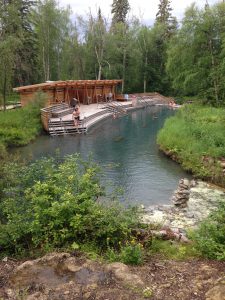
Liard Hot Springs makes it on the Great Canadian Bucket List for several reasons: Its wilderness location is located in a lush boreal setting, which adds to its ruggedness and charm. Photo: Jeremy Stewart
crossing the road, and saw a big black bear before calling it a day at Liard Hot Springs—the second largest hot spring in Canada. Spending an hour in a natural hot tub was the perfect way to end a great day …and to start the next one.
12 Hours to Watson Lake, Yukon
Although the next day started well with a bath in the hot springs, the good times didn’t last long. I was punished with freezing rain and wind, and my jacket, which is considered waterproof (except for the zippers), started to leak after a couple hours of torrential rain.
I had brought a 100 per cent waterproof over-jacket, but I noticed it was missing after I checked into the campsite the night before.
The weather was such that I only lasted about three hours before calling it a day and getting a hotel at Watson Lake. When I stopped, I could barely pull my gloves off to warm my hands on the engine. I had accomplished two days of 12-plus hours of riding, so I didn’t feel too badly about quitting early.
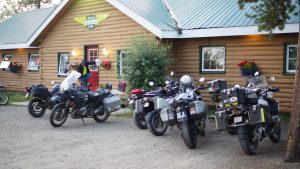
The Air Force Lodge in Watson Lake, Yukon. Photo: Jeremy Stewart
I stayed at the Air Force Lodge in Watson Lake. This is an interesting place, a building from the Second World War that has been restored and converted by a talkative character named Mike, originally from Northern Germany. A gang of Mexican adventure riders were staying there, too, but they weren’t as talkative.
Yukon’s capital city
After drying out, thawing out and enjoying a good rest, it was on to Whitehorse. This was a good day of easy riding and I
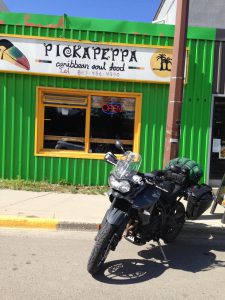
The Canadian melting pot of cultures—a Caribbean restaurant in the Yukon. Photo: Jeremy Stewart
reached the Yukon’s capital in time to get a late lunch. I have Caribbean heritage and was quite surprised to find a Caribbean restaurant in Whitehorse. I ate there and it was pretty good. Whitehorse felt more like a suburb of Vancouver than a frontier town in the great north. It was a good place to pick up some supplies (new rain jacket), have a good meal and gawk at some of the RV crowd.
Decision time—which route?
I found a good campsite at the edge of town and talked to a couple of other bikers. I hadn’t planned this trip beyond getting to the Yukon, as I didn’t want a schedule or deadlines. The only thing I had to do was make it home before July 16th. I talked to the bikers about what I should do next. With the amount of time I had left, I had two options: turn left or right at Haines Junction.
Turning right would have taken me to some interesting places: Tok and Chicken, Alaska; and Dawson City, Yukon. But this loop is 1,500 kilometres of mostly gravel, mud, and bad weather, which is slow-going for someone with little off-road experience and a bike equipped with street tires.
I’ve ridden more than 1,000 kilometres in a day in some really bad conditions on far less comfortable bikes, but I figured this turn would add at least three days to my trip, which meant the rest of the time would be rushed.
I didn’t make a decision until I stopped for coffee in Haines Junction. There, I caught up with Harry, who I had met the day before. Harry rode a Yamaha Super Tenere that had bull horns mounted on the front fender. He was heading north but had much more time than I did. He convinced me to take my time and enjoy the road.
If our conversation didn’t convince me to head south to the town of Haines, the skies did. Although it was 9am, the clouds made it as dark as night. The rain was pouring down and turning the road into mud. South sounded good.
Haines Highway’s spectacular scenery
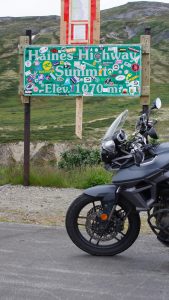
Haines Highway Summit: an elevation of 1,070 metres. Photo: Jeremy Stewart
The weather cleared up and although the road is pretty straight, the scenery is spectacularly surreal—glacial valleys with incredible views all around. Neither my photos nor my words can describe the sense of awe I felt while riding Haines Highway, all the while testing the limits of the Tiger’s engine.
I stopped at one of the scenic lookouts along the way and made lunch, staying there for more than two hours to marvel at the views. A few friendly people passed through that spot including a grizzled American on a beat-up Honda VTX. He’d been everywhere and had some great stories to share.
I discovered that this was just the beginning of great riding and scenery. Cruising down the Haines Highway at an elevation of 1,070 metres is the closest experience that I can imagine to being a fighter pilot. I kept passing and being passed by a Yamaha FJR. When I arrived at Haines I finally met its ‘pilot’, a Ukrainian who had ridden his bike all over the planet.
Skagway Ferry
My plan was to take the ferry from Haines to either Skagway, Alaska, or Prince Rupert, B.C.—the poor man’s Alaskan cruise. However, the $1,000 cost of a boat ride to P.R. smacked some sense into me. Besides, I was on this trip to ride a motorbike not sit in a motorboat.
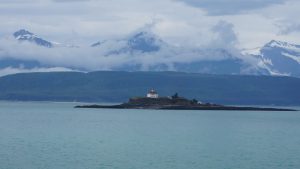
View from the Skagway Ferry, which allows riders to either walk on board, or bring their car, truck, RV, motorcycle, bicycle or kayak. Fares vary by distance, vehicle and size. Photo: Jeremy Stewart
The next ferry to Skagway had a stop in Juneau, Alaska, a significant detour, but it gave me a bit of a cruise for the same price as a direct ticket. I met a few interesting people on the boat, read a book and enjoyed some effortless travel.
Skagway is a tourist trap, but I didn’t mind staying there for a night. At the Skagway Brewing Company, I had the best bison burger, probably the best burger, and some of the best beers I’ve ever enjoyed. That was an easy day!
Up early the next morning and back into Canada. The road out of Skagway takes you up into the mountains through some more incredible scenery. So incredible that I didn’t realize I was doing double the 30-kilometre speed limit when approaching the customs building. The officer was not impressed and I was grateful that he let me back into the country with just a stern warning.
I had fantastic conditions all the way to the blue waters of B.C.’s Boya Lake Provincial Park. Along the way, there were more amazing wildlife sightings and great conversations with other travellers at every stop. Swimming in Boya Lake’s crystal clear water was also a nice way to end the day.
When in doubt, take the detour
Clouds rolled in overnight, providing lots of rain for the three-hour ride into Dease Lake, B.C. I refuelled the bike and reheated myself with coffee and lunch. I asked the locals about the weather forecast and the state of the road into Telegraph Creek—I had met a couple travellers the previous day who said it was worth the detour. Unfortunately, conversations with locals revealed they knew more about U.S. politics than the local conditions.
I decided to pass on the detour but after looking it up when I got back to the world of internet connections, I now regret doing so.
A few more hours down the road and I hit traffic. The road was closed because of a fatal accident and was going to stay that way until the coroner arrived. It was now too late to return to Telegraph Creek.
Lesson learned: When in doubt, take the detour route. Because of the road block I wouldn’t have been any further behind if I had taken the detour.
Seeing the accident was a sobering reminder of what can happen if you’re not careful, though. I used the delay to do some needed maintenance to the bike, go for a swim in Kinaskan Lake, smoke a cigar and read a few chapters.
160,000 kilometres on a Harley
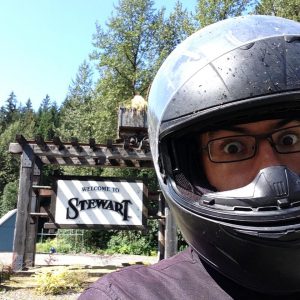
I didn’t know there was town named after me! Photo: Jeremy Stewart
Next stop was Stewart, B.C., and its neighbouring town Hyder, Alaska, which had been recommended to me by one of the people I met on the Skagway Ferry. The two towns are almost one save for a CAN/US border dividing them.
It is known as the place to see grizzly bears and there is also a road leading
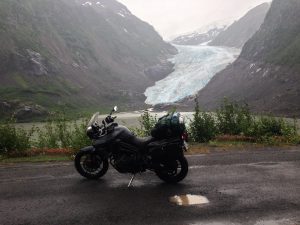
The road from Stewart carves through a myriad of glacial valleys. Photo: Jeremy Stewart
up to a glacier—two good reasons to visit. A third one is the road into town, which carves through deep canyons winding in and out of glacial valleys.
I didn’t see any grizzly bears, since it was too early in the season and the salmon weren’t running yet, but I did see a gnarly Harley covered in antlers and skulls at the side of the road.
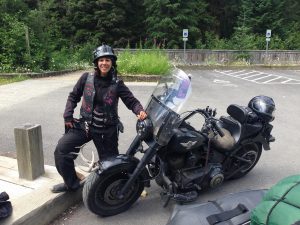
A Harley rider that has ratched up almost 160,000 kilometres on her bike. Photo: Jeremy Stewart
I needed directions, so I pulled over to talk to the owner, who proved to be even more interesting than the Harley. She was from Harlem, New York, and had ridden to all four corners of the U.S., racking up almost 160,000 kilometres on her 2012 Harley.
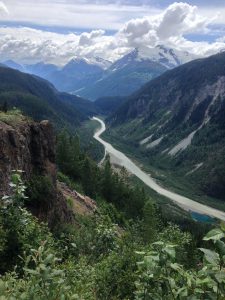
The Salmon River–every year around mid-July, Summit Lake which is located at the northern end of the Salmon Glacier, breaks an ice-dam and then flows under the Glacier into the Salmon River. Photo: Jeremy Stewart
Since there were no bears to be seen, I headed up the gravel road to the Salmon Glacier located just north of Stewart. There is an active gold mine at the end of the road and heavy mining trucks are constantly barrelling up and down. These drivers know the road well as they travel it all day. I did not, so riding this trail was “exciting”, to say the least. There’s no where to go if one of these trucks takes a corner a little too widely, you’re either going into a cliff, or off of one. When the trucks pass by, there is so much dust that anyone on the road is left with roughly three metres of visibility. However, once the dust settles, the unobstructed views are amazing.
It was hard to judge the scale-size of the glacier until one of the mining companies’ helicopters flew past.
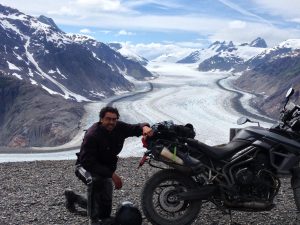
The surreal beauty of the Salmon Glacier as seen from Hyder, Alaska, near Stewart, B.C. Photo: Jeremy Stewart
That’s when I realized this huge block of ice was roughly the width of a small city.
New Hazelton, B.C.
After this long day of riding, it was back to Stewart for dinner and a place to spend the night. Controlling a bike on gravel roads is a good way to get an appetite and I enjoyed a large pizza. By the time I was finished eating, a storm was rolling in and all accommodation in this tiny town was booked. So, it was on to the next stop, New Hazelton.
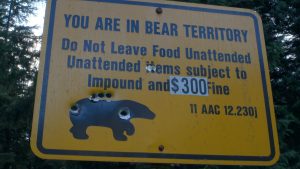
This signed was spotted in Haynes, B.C. Photo: Jeremy Stewart
It was really coming down as I cut back through the mountain canyons. Coming out of a corner, I saw a big black bear at the side of the road standing on his hind legs looking at me as if he were trying to hitch a ride. Sorry Mr. Bear, I didn’t bring an extra helmet!
I arrived in New Hazelton around midnight (my day had started at 6am). My motel room had a kitchenette where I was able to dry my boots, gloves and jacket in the oven before turning in for a good night’s sleep.
Okanagan sunshine?
The next day, I met other riders—one of whom was also riding a Tiger 800. They, too, were taking a break from the rain. They recommended a few roads around Vernon in the Okanagan. At this point, I really wanted to feel some of that Okanagan heat.
Vernon is a nostalgic place for me. I spent a few summers here, marching around its Cadet Training Camp. It appeared exactly the same as it did decades ago when I was there. Nothing had changed; I hope I have!
This time I decided to take the detour route and not the more direct roads via Lytton and Lillooet to
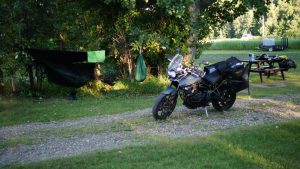
Making the best of the outdoors. Photo: Jeremy Stewart
Vancouver.
I had an exceptionally late start at 11am, but still made good time on the nice dry day. By sunset I was setting up camp, where I made a fire and had a few sips from my flask.
The next day’s start was once again filled with brutal rain. I was really looking forward to the Okanagan.
Thankfully, once I got to Cache Creek it was back to mid-July, and not mid-January, temperatures. I happily took off and packed away my jacket and let the desert air flow through my armored vest. The sun was shining, warm air flowing over me as I drove on twisty roads, past farms, vineyards and lakes. The Tiger’s engine purred like a kitten. Life felt good.
Food and refuelling took place in Vernon before I revisited the Cadet Training Camp. It seemed exactly the same as I remembered it from decades ago. Nothing appeared to have changed—I hope, though, that I have.
Last Day, Keremeos
I started looking for a campsite, but was enjoying the ride so much that I didn’t really want to pull over. In any event, the campgrounds that I did find were overflowing with RVs.
When it was finally getting to the point that I was running out of daylight, I found a spot in Keremeos. I couldn’t have asked for a better spot. I set up camp right next to the river and spent the rest of the night watching the stars and my fire, listening to the wind and the river and reflecting on the last couple weeks.
What a perfect way to spend the last night of my 7,500-kilometre journey.
Final thoughts
In the many years leading up to this trip, I talked to a few people about it. Having now completed this journey, here are my responses.
Aren’t you going to be lonely spending all that time by yourself?
Nope, every time I pulled over the other bikers I met treated me like a long-lost friend. Most of my photos are of scenery but I met so many interesting people from all over the world, it’s hard to say which was better.
That’s so dangerous, you might get in accident.
A man needs adventure. Lack of adventure leads to boredom and boredom can be just as dangerous.
You’re camping! What about bears?
What about math? About three people in all of North America might get killed by bears this year. What are the odds I’ll be one of them?
What about bad weather? Riding for hours in the rain; that sounds miserable.
Well I think Harry, the grizzled American I met on the trip, said it best before riding his Super Tenere north into an Arctic storm. “Adventures always suck when you’re in the middle of them.” That is true, and adventures always make for better stories than bragging about getting fat and drunk at an all-inclusive.
__________________________________________________
The bike

2016 Triumph Tiger 800 XR and the gear for a two-week trip to Alaska. Photo: Jeremy Stewart
The Tiger 800 XR ran perfectly. It handled great. It’s comfortable to ride long distances and light enough to make riding through rough terrain manageable. Powerful enough to still have lots of fun when carrying a couple weeks worth of gear. I did do a few modifications though. I added Barkbuster handguards, engine guards, and Caribou Command side cases.
I’ve been pretty happy with the Caribou Cases. They’re lighter, narrower and more economical than hard cases.
I sprayed the bike’s paint work with Plasti Dip and would recommend this to anyone going on a long trip and wanting to keep their bike looking new.
After my trip, the Plasti Dip coating was scratched and peeling and embedded with dust, bugs and grit. Without doubt, my bike’s paint would have been destroyed if it weren’t for this layer of protection. Plasti Dip is temporary and it was fairly easy to remove.
The one thing I should have done was to get more aggressive tires, or at least spend some time practicing riding off-road. Either would have been particularly useful for the Alaska Highway, which is either under constant repair, because of the extreme weather, or gravelled.
In retrospect, I would also have taken less stuff. I thought I took the minimum, but there was a lot that I could have left at home.
